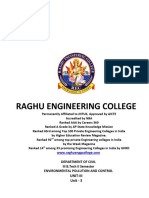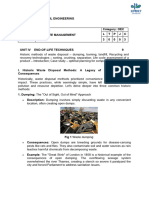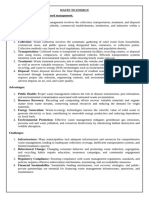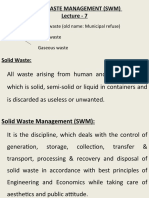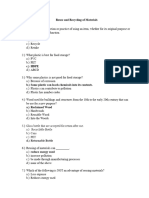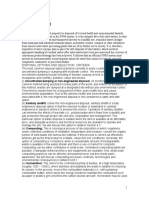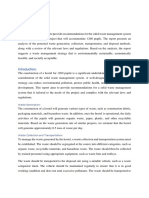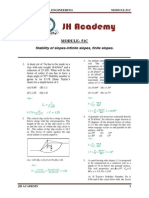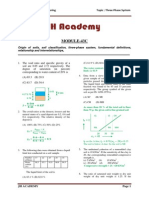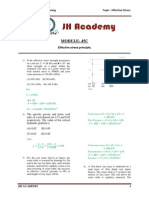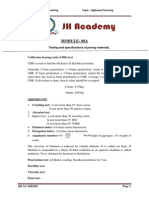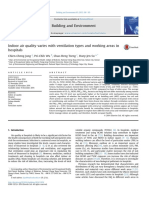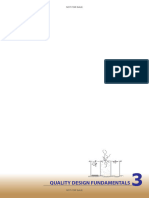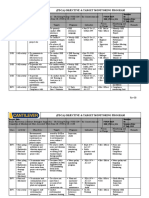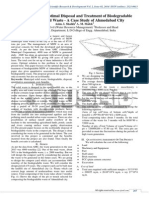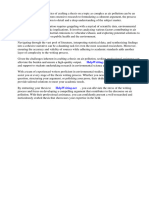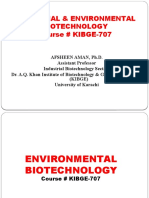Module-85A: Sub: Environmental Engineering Topic: Municipal Solidwastes
Module-85A: Sub: Environmental Engineering Topic: Municipal Solidwastes
Uploaded by
jhacademyhydCopyright:
Available Formats
Module-85A: Sub: Environmental Engineering Topic: Municipal Solidwastes
Module-85A: Sub: Environmental Engineering Topic: Municipal Solidwastes
Uploaded by
jhacademyhydOriginal Description:
Original Title
Copyright
Available Formats
Share this document
Did you find this document useful?
Is this content inappropriate?
Copyright:
Available Formats
Module-85A: Sub: Environmental Engineering Topic: Municipal Solidwastes
Module-85A: Sub: Environmental Engineering Topic: Municipal Solidwastes
Uploaded by
jhacademyhydCopyright:
Available Formats
Sub: Environmental Engineering
Topic : Municipal Solidwastes
MODULE- 85A
Muncipal solid wastes : Characteristics, generation, collection and transportation of solid wastes, engineered systems for solid waste management (reuse/ recycle, energy recovery, treatment and disposal).
___________________________________________________________________________ Solid wastes are the organic and inorganic waste materials such as product packing, grass clippings, furniture, clothing, bottles, kitchen refuse, paper, appliances, paint cans, batteries etc., produced in society. Which do not generally carry any value to the first users. Solid waste management: It is associated with the control of waste generation, its storage, collection, transfer and transport, processing and disposal in a manner that is in accordance with the best principles of public health, economics, engineering, conservation, aesthetics, public attitude and other environmental considerations. Waste characteristics: 1. Physical characteristics: a) Density: It is useful in design of sanitary landfills, storage, types of collection and transport vehicles etc. By compacting the waste, density can be increased. b) Moisture content: It increases the weight of solid wastes and treatment cost will go up in incineration. c) Size: Measurement of size distribution of particles in waste stream is important because of its significance in the design of mechanical separators and shredders. The physical properties that are essential to analyses wastes disposed at landfill are a) Field capacity: It is the moisture content which can be retained in waste sample subject to gravitational pull. It is a critical measure because water in excess of field capacity will form leachate and leachate can be a major problem in landfills. b) Permeability of compacted waste: It governs the movement of liquids and gases in a landfill. c) Compressibility: Degree of physical changes of the suspended solids or filter cake when subjected to pressure. 2. Chemical characteristics: Knowledge of the classification of chemical compounds and their characteristics is essential for the proper understanding of the behavior of waste, as it moves through the waste management system. The products of decomposition and heating values are to be used as fuel or are used for any other purpose, we must know their chemical characteristics. (i) Lipids: Fats, oils and greases are lipids. They have high heating values about 38,000 KJ/kg which makes waste with high lipid content suitable for energy recovery. JH ACADEMY Page 1
Sub: Environmental Engineering (ii)
Topic : Municipal Solidwastes
(iii)
(iv)
(v)
(vi)
Carbohydrates: Carbohydrates are readily biodegraded to products such as water, methane. Decomposing carbohydrates attracts flies and rats and therefore should not be left exposed for long duration. Proteins: Compounds containing carbon, hydrogen, oxygen and nitrogen and consists of an organic acid with a substituted amino group (N ). The partial decomposition of these compounds can result in production of amines that have unpleasant odours. Natural fibers: These are found in paper products, food and yard wastes and include the natural compounds, cellulose and lignin, that are resistant to biodegradation. They are suitable for incineration. Calorific values of overdried products are in the range of 12000-18000 KJ/kg. Plastic: They are suitable for recycling. Plastics have high heating value about 32000 KJ/kg which makes them suitable for incineration. But PVC when burnt produces dioxin and acid gas Non- combustibles: This class includes glass, ceramics, metals, dust and ashes.
Waste generation: the processing of raw materials is the first stage when wastes are generated, and waste generation continues thereafter at every step in the process as raw materials are converted into final products for consumption. We can reduce the amount of solid waste by limiting the consumption of raw materials and increasing the rate of recovery and reuse. There needs to be, therefore a societal change in the perception of wastes. This sounds simple. But, implementing changes in the society is difficult, unless appropriate management solutions are provided. Waste collection: waste collection does not mean merely the gathering of wastes and the process includes, as well as, the transporting of wastes to transfer stations or disposal sites. Collection components: 1. Collection points: These affect crew size and storage which ultimately control the cost of collection. 2. Collection frequency: Depends climatic conditions and locality. 3. Storage containers: Proper container selection can save collection energy, increase the speed of collection and reduce crew size. 4. Collection crew: The optimum crew size for a community depends on labor and equipment cost, collection methods, and route characteristics. 5. Collection route: The collection programme must consider the route that is efficient for collection. 6. Transfer station: It is an intermediate station between final disposal option and collection point in order to increase the efficiency of the system, as collection vehicles and crew remains closer for routes. 7. Collection vehicles: The collection vehicle selected must be appropriate to the terrain, type and density of waste generation points. Number of services/vehicle load N= C= vehicle capacity D= waste capacity W= waste generation/ resistance/ kg/ service JH ACADEMY Page 2
Sub: Environmental Engineering Time required collecting one load E: E=N L Number of loads /crew/day n:
Topic : Municipal Solidwastes
L= loading time/ residence including on-route travel
The number of loads n that each crew can collect in a day can be estimated based on the workday length t and the time spent on administration and breaks ( ), time for hauling and other ( ) and collection route time ( ) Administrative and break line time =A+B A= admin B= break Hauling and other travel time =n H= time to travel to disposal site empty truck& return to route = time to return from site to route = time to travel from staging garage to route = time to return from disposal site to garage. Time spent on collection route Length of work day = t = Where t is defined by work rules and equation A through D are solved for n Calculation of number vehicles and crews (K) K= S= total services in the collected area F= frequency of collection number/week M= number of working days per week Number of vehicle N= x= number of households a single truck can Service per day W= number of workers per week. =n
Disposal options: 1. Uncontrolled dumping or non-engineered disposal 2. Sanitary landfill JH ACADEMY Page 3
Sub: Environmental Engineering 3. Composting 4. Incineration 5. Gasification
Topic : Municipal Solidwastes
Recycling: Recycling is perhaps the most widely recognized from of source reduction involving the process of separating, collecting, processing, marketing and ultimately using a material that would have otherwise been discarded. Commonly recycled materials: Paper and cardboard, glass, metals, plastic, bacteria and tyres. Recovery of biological conversion products: Cand biogas. Composting is the biochemical degradation of the organic fraction of solid waste material having a humuslike final product that could be used primarily for soil conditioning. Bio gasification: Biogas is a mixer of gases composed of methane ( ) 40-70%, 30-60%, other gases 1-5% including . It originates from bacteria in the process of bio-degradation of organic material under anaerobic conditions. Incineration and energy Recovery: Incineration is a chemical reaction in which carbon, hydrogen and other elements in the waste mix oxygen in the combustion zone and generates heat. Energy recovery in the form of steam, which is used either to drive a turbine to generate electricity or directly for heating or coaling.
JH ACADEMY
Page 4
You might also like
- VCE Task 02 Ankit ChoudharyDocument6 pagesVCE Task 02 Ankit ChoudharyAnkit JaiswalNo ratings yet
- Soild Waste Management Q and ADocument19 pagesSoild Waste Management Q and AHamed FaragNo ratings yet
- Raghu Engineering College: Department of Civil III B.Tech II Semester Environmental Pollution and ControlDocument11 pagesRaghu Engineering College: Department of Civil III B.Tech II Semester Environmental Pollution and ControlAvinash Sai KalyanNo ratings yet
- SWMDocument15 pagesSWMhiyogsNo ratings yet
- Question Bank For CT 2 - 18CEE310T Solid and Hazardous Waste Management - Answer KeyDocument18 pagesQuestion Bank For CT 2 - 18CEE310T Solid and Hazardous Waste Management - Answer Keyhuman tie lineNo ratings yet
- Cve 517 NoteDocument28 pagesCve 517 NoteAdeleke SamuelNo ratings yet
- Lecture 17 AnylisDocument31 pagesLecture 17 AnylisyoyokhanyasirNo ratings yet
- UNIT-1 Lakshmana NaikDocument103 pagesUNIT-1 Lakshmana NaiknehamyaNo ratings yet
- Unit 4 Waste Management NotesDocument8 pagesUnit 4 Waste Management NotesHariniNo ratings yet
- Waste To EnergyDocument5 pagesWaste To Energyrijuanarahaman58No ratings yet
- EN6501 UnitDocument117 pagesEN6501 Unitpradeep vijayNo ratings yet
- Solid Waste ManagementDocument28 pagesSolid Waste ManagementSubhadeep ChakrabartiNo ratings yet
- Chapter 5Document29 pagesChapter 5Shita AlemieNo ratings yet
- Module - 12 SWM-1Document14 pagesModule - 12 SWM-1Faran MasoodNo ratings yet
- 6 mark GTDocument11 pages6 mark GTSibaprasad NayakNo ratings yet
- Evs A22Document13 pagesEvs A22Manas KulkarniNo ratings yet
- Municipal Solid Waste ManagementDocument100 pagesMunicipal Solid Waste ManagementPremkumar T100% (1)
- Tutorial Topic 4Document4 pagesTutorial Topic 4Afiq ArsyadNo ratings yet
- What Is Waste ManagementDocument6 pagesWhat Is Waste Managementrobenson indabNo ratings yet
- Solid Waste Management Evs ProjectDocument10 pagesSolid Waste Management Evs ProjectAbhishek60% (5)
- Chapter 3 Solide WasteDocument80 pagesChapter 3 Solide WasteTes FitNo ratings yet
- 2 ModDocument16 pages2 ModIrfan PeruvallithodiNo ratings yet
- Tutorial Topic 5Document5 pagesTutorial Topic 5Afiq ArsyadNo ratings yet
- Presentation 2Document20 pagesPresentation 2Yusif AgayevNo ratings yet
- Scientific Travel To Kwashe Leachate Treatment Plant and Landfill ImprovementDocument15 pagesScientific Travel To Kwashe Leachate Treatment Plant and Landfill Improvementhayder alaliNo ratings yet
- Institutional Solid Waste ManagementDocument34 pagesInstitutional Solid Waste ManagementdaabgchiNo ratings yet
- Recycling of Plastics - A Materials Balance Optimisation Model PDFDocument14 pagesRecycling of Plastics - A Materials Balance Optimisation Model PDFLeoChokNo ratings yet
- Gestão de Resíduos SólidosDocument114 pagesGestão de Resíduos SólidosEliúd AntoniaNo ratings yet
- Waste Disposal and Effluent TreatmentDocument4 pagesWaste Disposal and Effluent TreatmentEnaye MajiriNo ratings yet
- Lecture Notes - 15 PagesDocument15 pagesLecture Notes - 15 PagesÄhmèd ÃzàrNo ratings yet
- Chapter 3Document47 pagesChapter 3tilahunkasaNo ratings yet
- Anna University, Chennai-Affiliated Institutions R - 2013 B.E. Civil Engineering Semester-Vii - Syllabus Elective - IiiDocument28 pagesAnna University, Chennai-Affiliated Institutions R - 2013 B.E. Civil Engineering Semester-Vii - Syllabus Elective - Iiipraveen murugesanNo ratings yet
- Environmental StudiesDocument19 pagesEnvironmental Studiespriyanshu guptaNo ratings yet
- Report On Analysis of Solid and WasteDocument4 pagesReport On Analysis of Solid and WasteRohan sharmaNo ratings yet
- Group 14 QuestionnaireDocument5 pagesGroup 14 QuestionnaireDrakie SumanilNo ratings yet
- Previous Year Solution of Solid Waste ManagementDocument15 pagesPrevious Year Solution of Solid Waste Managementudishasinghus09No ratings yet
- EGR 2302 SLP MidreportDocument8 pagesEGR 2302 SLP MidreportNissrine El AllamiNo ratings yet
- Proposal of Suitable Solid Waste Management Method For A Town in PhilippinesDocument11 pagesProposal of Suitable Solid Waste Management Method For A Town in Philippinesabalaji_10No ratings yet
- Energy Recovery From Solid Waste For Nazareth/Adama City, EthiopiaDocument12 pagesEnergy Recovery From Solid Waste For Nazareth/Adama City, EthiopiaMelakuNo ratings yet
- Waste DisposalDocument5 pagesWaste DisposalCharan ReddyNo ratings yet
- Solid Waste ManagementDocument8 pagesSolid Waste ManagementIsaac Kwabena HinnehNo ratings yet
- Solid Creat Mod-2Document35 pagesSolid Creat Mod-2md shakil ahsan mazumderNo ratings yet
- EE 80s Study Guide CompleteDocument20 pagesEE 80s Study Guide CompleteCarson Barbeau100% (1)
- 16 mark GTDocument8 pages16 mark GTSibaprasad NayakNo ratings yet
- Green Logistic: A Case Study of Solid Urban Waste RecyclingDocument8 pagesGreen Logistic: A Case Study of Solid Urban Waste RecyclingmaviceconteNo ratings yet
- Principles of Municipal Waste MGMTDocument27 pagesPrinciples of Municipal Waste MGMTfaridkhan0% (1)
- EPCLectureNotes Solid Waste2Document6 pagesEPCLectureNotes Solid Waste2Harshini Reddy B.No ratings yet
- 2.0 Material CycleDocument4 pages2.0 Material CycleAliciaNo ratings yet
- 11-12 Phases of Solis Waste Collection and Composting.Document32 pages11-12 Phases of Solis Waste Collection and Composting.eng zamNo ratings yet
- EESTPartAVol2355 69Document31 pagesEESTPartAVol2355 69Gautham MGNo ratings yet
- Solid Waste ManagementDocument8 pagesSolid Waste ManagementRyuuNo ratings yet
- MSW - Unit Ii QpbankDocument5 pagesMSW - Unit Ii QpbankPremkumar TNo ratings yet
- Chapter - 2 & 3WSEE-4192Document39 pagesChapter - 2 & 3WSEE-4192teferatamene21No ratings yet
- Problem 1Document5 pagesProblem 1Thuy NguyenNo ratings yet
- CHAPTER 6.0 Sustainable and Green EngineeringDocument41 pagesCHAPTER 6.0 Sustainable and Green Engineeringnurin100% (1)
- Climate Exodus: A Statistical Analysis of Displacements and Projections Towards an Uncertain Future: Research published in English, #4From EverandClimate Exodus: A Statistical Analysis of Displacements and Projections Towards an Uncertain Future: Research published in English, #4No ratings yet
- CO2 and Global Temperature: The Case of the United States to 2030.: Research published in English, #10From EverandCO2 and Global Temperature: The Case of the United States to 2030.: Research published in English, #10No ratings yet
- Unlocking Green Energy : A Practical Look at Biogas Production Using Agricultural Biomass and Organic WasteFrom EverandUnlocking Green Energy : A Practical Look at Biogas Production Using Agricultural Biomass and Organic WasteNo ratings yet
- RankersDocument2 pagesRankersjhacademyhydNo ratings yet
- F First Revision: Method For Subsurface So-Und-Ing For SoilsDocument11 pagesF First Revision: Method For Subsurface So-Und-Ing For SoilsAbhijeet SwainNo ratings yet
- JH Academy: Gate-2014 4Th Year StudentsDocument2 pagesJH Academy: Gate-2014 4Th Year StudentsjhacademyhydNo ratings yet
- RankersDocument2 pagesRankersjhacademyhydNo ratings yet
- 51CDocument6 pages51Cjhacademyhyd100% (5)
- RankersDocument2 pagesRankersjhacademyhydNo ratings yet
- 43CDocument17 pages43Cjhacademyhyd100% (4)
- 44CDocument9 pages44Cjhacademyhyd100% (3)
- JH Academy: Gate-2014 4Th Year StudentsDocument2 pagesJH Academy: Gate-2014 4Th Year StudentsjhacademyhydNo ratings yet
- 50CDocument6 pages50Cjhacademyhyd89% (9)
- 45CDocument8 pages45Cjhacademyhyd100% (4)
- Module-72A: Design Of: Lined and Unlined Canals, Waterways, Head Works, Gravity Dams and SpillwaysDocument4 pagesModule-72A: Design Of: Lined and Unlined Canals, Waterways, Head Works, Gravity Dams and SpillwaysjhacademyhydNo ratings yet
- 3BDocument2 pages3Bjhacademyhyd100% (1)
- TEST-6: Sub: Fluid Mechanics Module: 63-66Document2 pagesTEST-6: Sub: Fluid Mechanics Module: 63-66jhacademyhydNo ratings yet
- 1BDocument5 pages1BjhacademyhydNo ratings yet
- Module-55A: Sub: Water Resources Engineering Topic: Fluid Mechanics & HydraulicsDocument2 pagesModule-55A: Sub: Water Resources Engineering Topic: Fluid Mechanics & HydraulicsjhacademyhydNo ratings yet
- Test 5Document2 pagesTest 5jhacademyhydNo ratings yet
- Module-88A: Sub: Transportation Engineering Topic: Highway PlanningDocument4 pagesModule-88A: Sub: Transportation Engineering Topic: Highway PlanningjhacademyhydNo ratings yet
- Module-73A: Sub: Water Resources Engineering Topic: Irrigation EngineeringDocument6 pagesModule-73A: Sub: Water Resources Engineering Topic: Irrigation EngineeringjhacademyhydNo ratings yet
- Module 63aDocument6 pagesModule 63ajhacademyhydNo ratings yet
- Module-74A: Sub: Water Resources Engineering Topic: Irrigation EngineeringDocument3 pagesModule-74A: Sub: Water Resources Engineering Topic: Irrigation EngineeringjhacademyhydNo ratings yet
- Module-87A: Sub: Transportation Engineering Topic: Highway PlanningDocument9 pagesModule-87A: Sub: Transportation Engineering Topic: Highway PlanningjhacademyhydNo ratings yet
- Module-80A: Sub: Environmental Engineering Topic: Waste Water EngineeringDocument3 pagesModule-80A: Sub: Environmental Engineering Topic: Waste Water EngineeringjhacademyhydNo ratings yet
- Module-78A: Sewage and Sewerage Treatment, Quantity and Characteristics of WastewaterDocument4 pagesModule-78A: Sewage and Sewerage Treatment, Quantity and Characteristics of WastewaterjhacademyhydNo ratings yet
- Module 79aDocument1 pageModule 79ajhacademyhydNo ratings yet
- Module-82A: Sub: Environmental Engineering Topic: Waste Water EngineeringDocument4 pagesModule-82A: Sub: Environmental Engineering Topic: Waste Water EngineeringjhacademyhydNo ratings yet
- MODULE - 3 Notes 18ME751 ENERGY & ENVIRONMENTDocument7 pagesMODULE - 3 Notes 18ME751 ENERGY & ENVIRONMENTNaru MNo ratings yet
- Hazclean Er MsdsDocument4 pagesHazclean Er Msdszubair1951No ratings yet
- Building and Environment: Chien-Cheng Jung, Pei-Chih Wu, Chao-Heng Tseng, Huey-Jen SuDocument6 pagesBuilding and Environment: Chien-Cheng Jung, Pei-Chih Wu, Chao-Heng Tseng, Huey-Jen SuEmanuel RodriguesNo ratings yet
- 03 - Stormwater MSMA 2nd 2012 - Quality Design FundamentalsDocument19 pages03 - Stormwater MSMA 2nd 2012 - Quality Design Fundamentalsang.xicongNo ratings yet
- Jinn PPT Waste ManagementDocument24 pagesJinn PPT Waste ManagementMayrafie DuloyNo ratings yet
- Presidential Decree No. 1152: SubjectDocument9 pagesPresidential Decree No. 1152: SubjectJane SalvadorNo ratings yet
- PDCA Objective and Targets Monitoring ProgramdocxDocument3 pagesPDCA Objective and Targets Monitoring ProgramdocxZulhaidy Salim100% (1)
- The Ecofriendly Optimal Disposal and Treatment of Biodegradable Municipal Solid Waste - A Case Study of Ahmedabad CityDocument3 pagesThe Ecofriendly Optimal Disposal and Treatment of Biodegradable Municipal Solid Waste - A Case Study of Ahmedabad Cityvijay_aashiqNo ratings yet
- Lead Paint Removal GuidesDocument669 pagesLead Paint Removal GuidesHenryZambrano100% (1)
- Environmental Management Past Papers - 2 - May June-2021Document20 pagesEnvironmental Management Past Papers - 2 - May June-2021Riyad JaberNo ratings yet
- Soil PollutionDocument5 pagesSoil PollutionFrancisNo ratings yet
- Printing IndustryDocument4 pagesPrinting IndustryQUALITY CONTROLNo ratings yet
- MA XX XX RP D CLP01C CRE Construction Logistics Plan FullDocument35 pagesMA XX XX RP D CLP01C CRE Construction Logistics Plan FullMohammedSajidNo ratings yet
- JOYA SHARMA SEAT NO. (214058) PRN NO. (2020033800058804 (Solid Waste Management Municipality and Municipal Corporation)Document20 pagesJOYA SHARMA SEAT NO. (214058) PRN NO. (2020033800058804 (Solid Waste Management Municipality and Municipal Corporation)Jatin SoniyaNo ratings yet
- ECL Angol Tetelek C1Document31 pagesECL Angol Tetelek C1dNo ratings yet
- Case StudyDocument12 pagesCase StudyNUR SYAHIDAH MOHAMAD SHUKRINo ratings yet
- Thesis Title About Air PollutionDocument8 pagesThesis Title About Air Pollutionlindagosnellfortwayne100% (2)
- Enzyme Technology (Lecture#9 - Environmental Biotechnology)Document18 pagesEnzyme Technology (Lecture#9 - Environmental Biotechnology)ZiwaqarNo ratings yet
- Bioremediation Techniques For Polluted Environment - Concept, Advantages, Limitations, and Prospects IntechOpenDocument33 pagesBioremediation Techniques For Polluted Environment - Concept, Advantages, Limitations, and Prospects IntechOpenMir jaliesNo ratings yet
- Unit 7:environmental ProtectionDocument4 pagesUnit 7:environmental ProtectionLê Tường VyNo ratings yet
- đọc hiểu 1Document9 pagesđọc hiểu 1Thu Trang PhạmNo ratings yet
- Clean Air Act - Lesson Plan Day 1Document2 pagesClean Air Act - Lesson Plan Day 1laurahelenkingNo ratings yet
- CEE361 Exam2PracticeDocument6 pagesCEE361 Exam2PracticeFahad AreebNo ratings yet
- The Ecological Footprint Poster Adobe ReaderDocument1 pageThe Ecological Footprint Poster Adobe ReaderChika OlakitanNo ratings yet
- 7th Ise SyllabusDocument6 pages7th Ise SyllabusDHANUSH KILVIDHI VIJAYNo ratings yet
- Report - Ve ExternalitiesDocument22 pagesReport - Ve Externalitiesainmazni5No ratings yet
- Highways and Roads Guidelines 1 PDFDocument53 pagesHighways and Roads Guidelines 1 PDFSP M TamizhNo ratings yet
- G20 Report: Practices of Innovative Public Procurement For Smart Cities and Communities Page 1 of 34Document34 pagesG20 Report: Practices of Innovative Public Procurement For Smart Cities and Communities Page 1 of 34Russell FernandezNo ratings yet
- Environmental LawDocument18 pagesEnvironmental LawAlok shahNo ratings yet
- EIA ReportDocument188 pagesEIA ReportChan KianNo ratings yet


